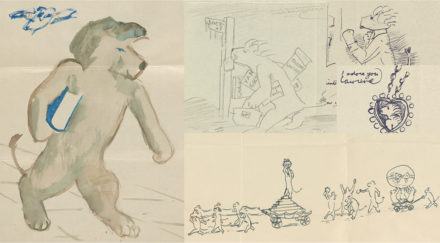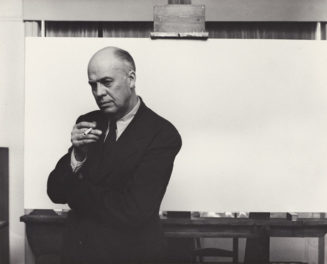
Jitterbug (from Copacetic Suite), 2018–2019, Alison Saar. Multi-block color linocut on Japanese kozo paper, 19 1/2 x 18 in. Image © Alison Saar. Courtesy of L.A. Louver, Venice, CA
Early in 2020, at the time of the Frieze Los Angeles art fair, the Getty Research Institute acquired Los Angeles-based artist Alison Saar’s series of eight multi-block linocuts on kozo paper, titled Copacetic Suite (2018–2019). Evoking the mental spaces of performers and audiences—some private, others in-the-groove and connected—the deep and varied colors of the prints are about the moods of music: sung, played, danced, and simply heard.
Sound hovers and swirls. The music calls up ghostly figures from the linocuts’ textured surfaces and backgrounds, creating spiritual, as well as mysterious, moments. The saxophone in Shebop is literally smoking; Jitterbug dancers are joined by a spectral third partner; Hepcat, a listener, turns inquisitively toward the viewer; the singer in Torch Song holds her flames like a bouquet. Viewers can make up whatever story they like, since the figures depicted in the linocuts don’t seem real. Saar’s grainy surfaces and outlines express the force of feelings, the experience of becoming lost in music or transported by it, no matter whether performing or listening.

Torch Song (from Copacetic Suite), 2018–2019, Alison Saar. Multi-block color linocut on Japanese kozo paper. Image © Alison Saar. Courtesy of L.A. Louver, Venice, CA
Meaning “it’s fine,” copacetic is a cool word to use as the title of this print series and to explain its mood. In its oblique acknowledgment that things are in synch, even working quite well, copacetic’s historic usage reaches back to early 20th-century songs. It’s found in “At the New Jump Steady Ball,” recorded by Ethel Waters in 1921. After a list of alcoholic beverage possibilities at the speakeasy, she sings “Copacetic was the best way for one and all.”

Shebop (from Copacetic Suite), 2018–2019, Alison Saar. Multi-block color linocut on Japanese kozo paper. Image © Alison Saar. Courtesy of L.A. Louver, Venice, CA

Hepcat (from Copacetic Suite), 2018–2019, Alison Saar. Multi-block color linocut on Japanese kozo paper. Image © Alison Saar. Courtesy of L.A. Louver, Venice, CA
We can mix interior adventures offered by music with the more visceral satisfactions of the palate with the L.A. Louver gallery’s gift of Saar’s cookbook, Recipes for Trouble, which includes selected comfort-food recipes and playlists to accompany them. Illustrated with Saar’s artworks, the cookbook is a trifecta for the Research Institute’s special collections (at once an artist’s book and an illustrated cookbook, and drawn from African American culture). You can find the book reproduced on L.A. Louver’s website, and it’s the perfect thing for these long days and weeks sheltering at home: you can read, laugh, and then cook up the recipes in time with the recommended tunes. Saar’s text puts it all together on the title page: “Conjurin’ in the kitchen is about the feel more than measurement. The syncopation of ingredients is essential. Improvisation strongly encouraged.”

Kitchen Amazon, 2019, from Recipes for Trouble, Alison Saar. Wood, ceiling tin, barbed wire, tar, found skillets, linoleum, and found chain. Image © Alison Saar. Courtesy of L.A. Louver, Venice, CA
If there was a subtlety you might have missed in Copacetic Suite, explicit information can be found in the recipes. “Good Money Greens,” to be eaten on New Year’s Day, are paired with Charles Mingus’s “Goodbye Pork Pie Hat” or Daddy Hotcakes’ “Mustard Greens. The cookbook’s closer is “‘Put your foot in it’ Sweet Potato Pie,” accompanied by Nina Simone’s “I Want A Little Sugar in My Bowl.” Saar writes, “EAT with your lover. GET under the covers.” Enough said. Look, listen, travel in your headspace, and most importantly, dine well.




I have a early print of hers of a cow that i bought at a benefit for the California college of arts and crafts